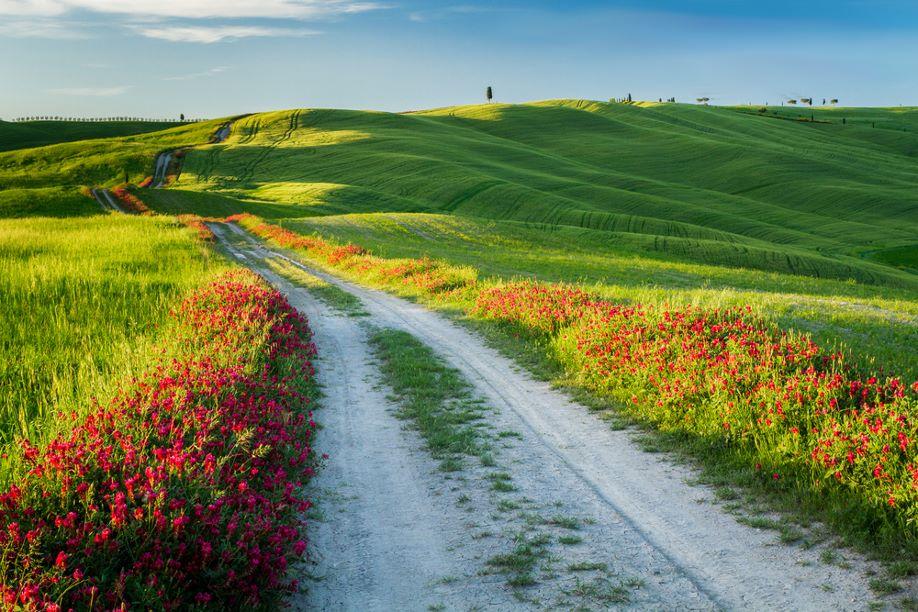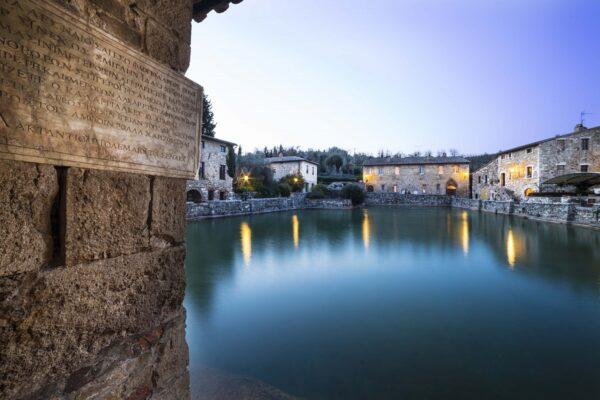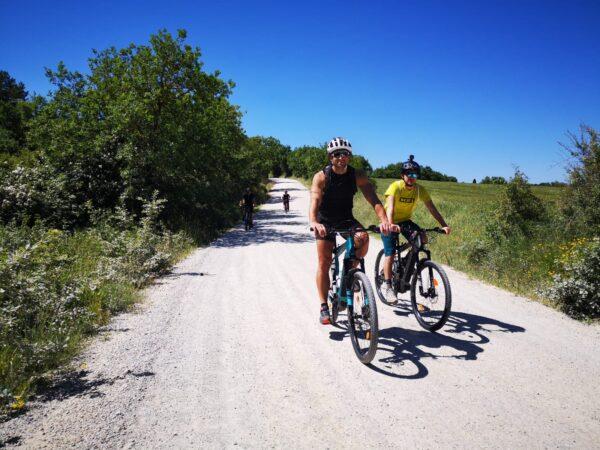
Il magnifico scenario naturale della Val d’ Orcia si estende attraverso le colline toscane ed è stato inserito sulla lista del patrimonio mondiale dell’UNESCO nel 2004.
La Val d’ Orcia racchiude l’arte , il paesaggio e l’ecosistema in uno spazio geografico ristretto , è l’espressione di una serie di caratteristiche naturali meravigliose . In realtà , secondo l’UNESCO questa Valle è un esempio eccezionale del modo in cui un ambiente naturale è stato ridisegnato durante il Rinascimento ( 14a-15a secoli ) , riflette gli ideali del buon governo dello Stati Italiano nella città infatti queste splendide località sono state celebrate dai pittori della Scuola Senese che fiorì tra il 13 ° e il 15 ° secolo .
Le immagini della Val d’Orcia , e in particolare le riproduzioni dei suoi paesaggi , in cui si descrivono i cittadini che vivono in armonia con la natura , sono diventate icone Rinascimentali . Un esempio perfetto sono gl affreschi ” Allegorie ed effetti del Buono e del Cattivo Governo ” nel Palazzo Pubblico di Siena di Ambrogio Lorenzetti . 1338-1339 . Le due rappresentazioni non sono solo un capolavoro in termini artistici , ma un lavoro che va sopra e oltre il semplice valore artistico.
Colline dolcemente ondulate coperte di fitta vegetazione di vigneti, oliveti , cipressi, faggi e castagni si alternano a abitazioni medievali , ville rurali e castelli – che si diffondono in una natura tranquilla isolata . Questo è lo scenario davanti agli occhi del visitatore per la Val d’ Orcia – evocativa nella vita reale , come lo rappresentato i Maestri senesi .
Val d’ Orcia ha intrecciato la sua storia con la Via Cassia , la strada romana estremamente lunga che collega Roma al Nord Italia , attraversando tutta la Val d’Orcia .
La storia viaggia attraverso questa antica via consolare che è stata testimone della storia in questa parte della Toscana, che è un sogno ambito da molti.
Castiglione d’ Orcia , Montalcino , Pienza , Radicofani e San Quirico d’ Orcia sono i cinque splendidi comuni che hanno scelto di ri- valutare il Parco della Val d’ Orcia , la tutela dell’ambiente e del territorio , e promuovendo il brand Val d’Orcia
Contignano , Monticchiello , Bagno Vignoni , Rocca d’ Orcia , Campiglia d’Orcia , Bagni San Filippo e Vivo d’ Orcia sono alcuni degli altri magnifici luoghi sparsi in tutta la Valle – sono tutti punti di contatto ideali da cui prendono un viaggio a ritroso nella sua affascinante e riccamente evocativo passato. La ricchezza e la varietà dei paesaggi non sono gli unici elementi che caratterizzano il territorio incontaminato della zona ; vi è anche la produzione enogastronomica tra cui in primis il cacio pecorino di Pienza , il miele della Val d’Orcia , olio extra vergine di oliva, il salame di cnta senese , così come funghi, tartufi accompagnato dal vino più famoso del mondo, il Brunello di Montalcino.
The magnificent natural scenery of the Val d’Orcia that extends through the Tuscan hills was inserted onto the UNESCO World Heritage List in 2004.
Val d’Orcia fuses art, landscape and ecosystem in one geographical space, and is the expression of a series of marvelous natural characteristics. It is also the result of and testament to the people that has long-inhabited it. In fact, according to UNESCO this Valley is an exceptional exemplar of the way in which a natural setting was redesigned during the Renaissance (14th-15th Centuries), reflecting the ideals of good governance in the Italian City-State. Additionally, these splendid localities were celebrated by the painters of the Sienese School, which flourished between the 13th and 15th Centuries.

The images of Val d’Orcia, and particularly the reproductions of their landscapes, in which they depict citizens living in harmony with nature, became icons for the Renaissance Age. A perfect example is Ambrogio Lorenzetti’s fresco cycle “Allegories and Effects of Good and Bad Government” in Siena‘s Palazzo Pubblico from c. 1338-39. The cycle is not only a masterpiece in artistic terms, but a work that goes above and beyond merely artistic value: it transcends such, also comprising architectonic, environmental and social themes.
Gently-rolling hills covered in the dense vegetation of vineyards, olive groves, cypresses, beech and chestnut trees alternate with Medieval habitations, rural villas and castles boasting impervious towers – all of which is diffused in a tranquilly-isolated nature. This is the scenario that is laid out before the eyes of the visitor to Val d’Orcia – just as evocative in real life as it is when depicted by the Sienese Masters.
Five-million years of geological history have left their mark on this territory that, today, is abundant in plant and animal species. Even the deposits of lava from volcanoes no longer active – such as Mounts Radicofani and Amiata – have contributed to the delineations and details of the area; the lava, hardened, gave form to those dark stones known as trachytes. The trachytes succeed each other one after the other, accompanying the River Orcia a sit cuts the Valley in two, before exiting via a deep cleft.
Val d’Orcia has weaved its history with the Via Cassia, the extremely long Roman road that links Rome to Northern Italy, crossing through the entire Val d’Orcia.
History travels this ancient via consulare that has been witness to the turn of time through the centuries, in this part of Tuscany that is a dream coveted by many.
A street that traces the history of the Via Francigena means that the thrill of the journey resides in the sense and spirit of the pilgrimage of the faithful.
The continuous transit of men and commerce along this fundamental pathway connoted the importance of town centers that eventually attracted the interest of the Republic of Siene in the 15th Century.
After the mid-1500s, Val d’Orcia became a valuable part of the Florentine orbit – together with the Sienese dominions – solely for its important agricultural aspect.
Castiglione d’Orcia, Montalcino, Monticchiello and Pienza, Radicofani and San Quirico d’Orcia are the five splendid communes that have chosen to re-appraise the Park of Val d’Orcia, protecting the environment and the territory, and promoting the Val d’Orcia “brand.”
Contignano, Monticchiello, Bagno Vignoni, Rocca d’Orcia, Campiglia d’Orcia, Bagni San Filippo, and Vivo d’Orcia are some of the other magnificent spots scattered throughout the Valley – all are ideal jumping-off points from which to take a trip back into its fascinating and richly-evocative past. The richness and variety of the scenery are not the only unique elements that characterize the area’s pristine terrain; there is also the enogastronomic production, indeed one of Val d’Orcia’s primary fortes. Such includes the cacio pecorino of Pienza, the honey from Val d’Orcia, extra-virgin olive oil from Castiglione d’Orcia, the salames of Cinta Senese, as well as mushrooms, truffles, and everything else that is, of course, accompanied by the most famous wine in the world – Brunello di Montalcino.




